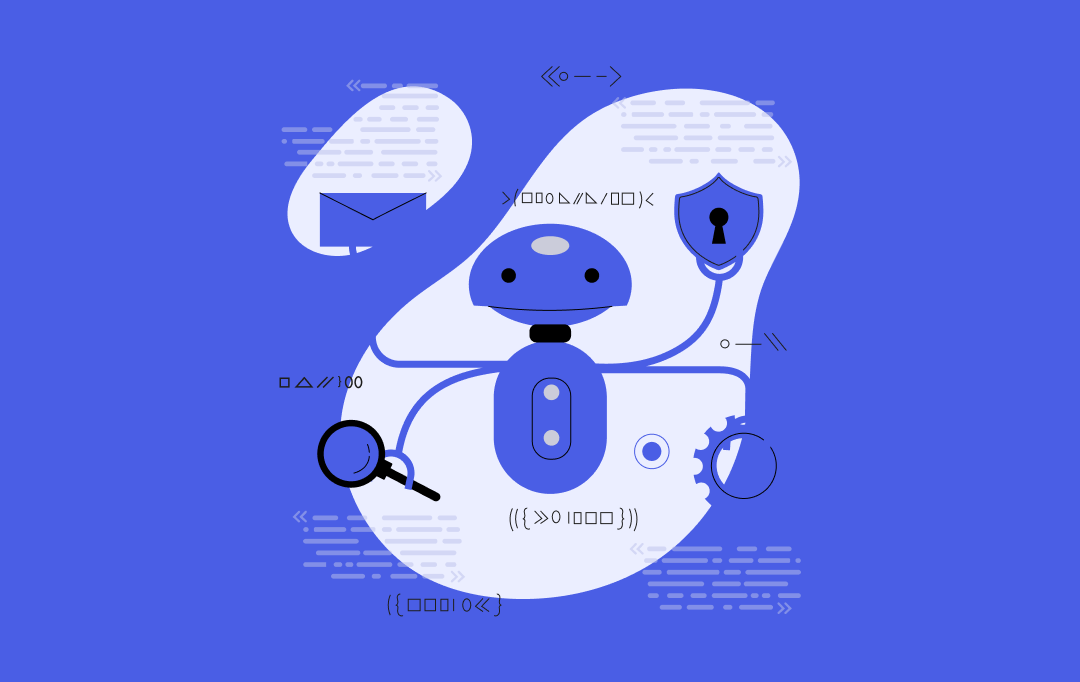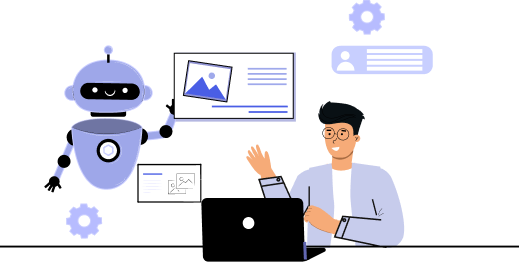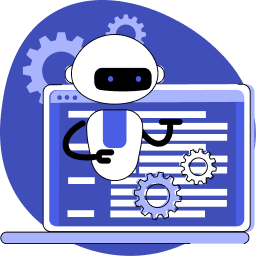- The Chasm Between Aspiration and Reality
- 11 AI Adoption Barriers You Must Conquer (With Solutions and Success Stories)
- Barrier 1: Lack of Strategic Vision and Alignment
- Barrier 2: Data Quality, Availability, and Integration Issues
- Barrier 3: Skills Shortage and Change Resistance
- Barrier 4: Trust, Ethics, and Regulatory Compliance
- Barrier 5: Cost, Scalability, and ROI Uncertainty
- Barrier 6: The Challenge of Vendor Lock-In
- Barrier 7: Overcoming Legacy System Challenges
- Barrier 8: The Hidden Barrier of Organizational Culture
- Barrier 9: AI Security and Privacy Risks
- Barrier 10: The Complexity of Measuring Full Value
- Barrier 11: The Pace of Technology vs. The Pace of the Organization
- Putting It All Together: Your Strategic Framework for AI Success
- Your Prioritization Roadmap
- How Appinventiv Helps You Overcome AI Adoption Barriers
- Frequently Asked Questions (FAQs)
Key takeaways:
- Align AI with Strategy: Define clear, business-aligned AI goals with measurable outcomes to escape “pilot purgatory,” as Microsoft achieved with $13B in AI revenue.
- Strengthen Data Infrastructure: Tackle data silos and quality issues using governance, integration tools, and cloud platforms, like Amazon’s AWS, driving 35% of sales.
- Invest in People and Culture: Overcome skills gaps and resistance through upskilling and innovation-focused culture, as Unilever boosted productivity by 41%.
- Mitigate Risks Effectively: Address ethics, security, and ROI uncertainty through privacy-by-design principles, governance frameworks, and agile implementation strategies.
Your competitors are already winning. While you’ve been evaluating AI strategies, they’re deploying machine learning systems that slash operational costs, accelerate product development, and capture your market share. The window for competitive AI advantage is rapidly closing, and organizations still treating AI as a future consideration risk becoming irrelevant. The brutal reality: AI laggards don’t just fall behind, they get acquired or disappear entirely.
Yet here lies the challenge: amid substantial hype and genuine potential, countless organizations find themselves trapped within what industry experts term “pilot purgatory.” They run exciting pilot projects that show great promise, but those projects never seem to make it to a full, profitable launch. Why? Because the real work isn’t just in understanding what AI is. It’s in tackling the very real enterprise AI adoption challenges that stand in the way. For many businesses, the path to AI success is less of a straight line and more of an obstacle course.
In this blog, we’ll walk you through eleven of the most significant barriers you’ll encounter and provide a roadmap for how you can overcome them.
Your competitors are winning while you evaluate. Break through pilot purgatory and turn AI adoption challenges into competitive advantages that drive growth.
The Chasm Between Aspiration and Reality
By 2026, experts predict that 40% of all enterprise applications will use task-specific AI agents. That’s a massive leap that promises to redefine how we work and compete. But why, in an era of such profound technological advancement, does this struggle persist? The answer is a chasm between aspiration and reality. While a majority of leaders express a strong commitment to AI, many fall into the “experimentation trap.” They greenlight exciting, small-scale pilots that demonstrate capability but lack a clear path to production.
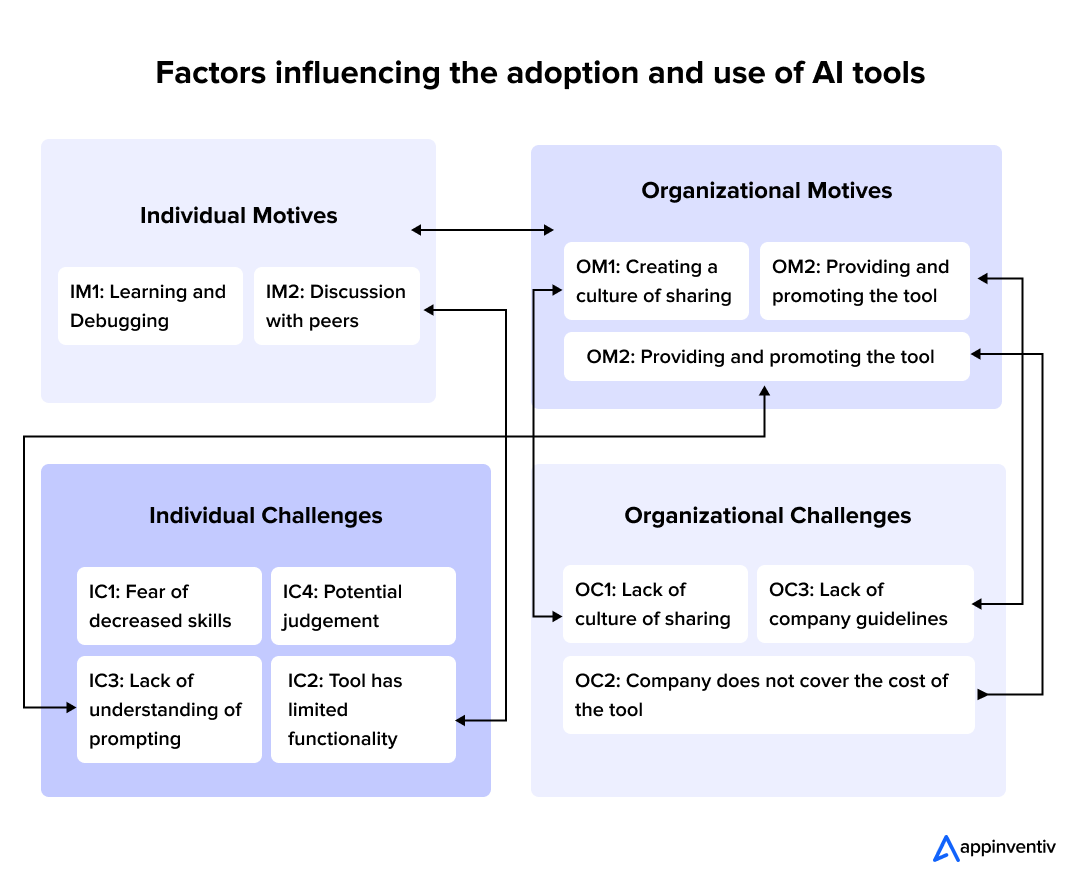
These projects are often a matter of ticking a box, a response to a competitor’s latest move, rather than a genuine attempt to rewire the business for the future.
The stark reality of this disconnect is captured in recent research:
Despite enterprises investing between $30 to $40 billion in generative AI, 95% of AI pilot programs are failing to achieve measurable impact on profits and revenue. The result is a patchwork of isolated successes with no cohesive thread. This disconnect between what organizations want to achieve and what they are truly prepared to do is the very reason so many AI adoption in business initiatives falter. It highlights that AI is not a tool to be simply purchased and deployed, but a new operating model that requires a fundamental transformation from the ground up.
11 AI Adoption Barriers You Must Conquer (With Solutions and Success Stories)
We’ve talked about pilot purgatory, but what actually stops AI projects from working? Some projects fail because of bad planning, while others crash into technical walls. Sometimes teams just don’t want to change how they work. Regulatory issues can also kill projects. Knowing what these roadblocks look like helps you spot them early. That’s how you get from endless pilots to AI that ultimately changes how your business operates.
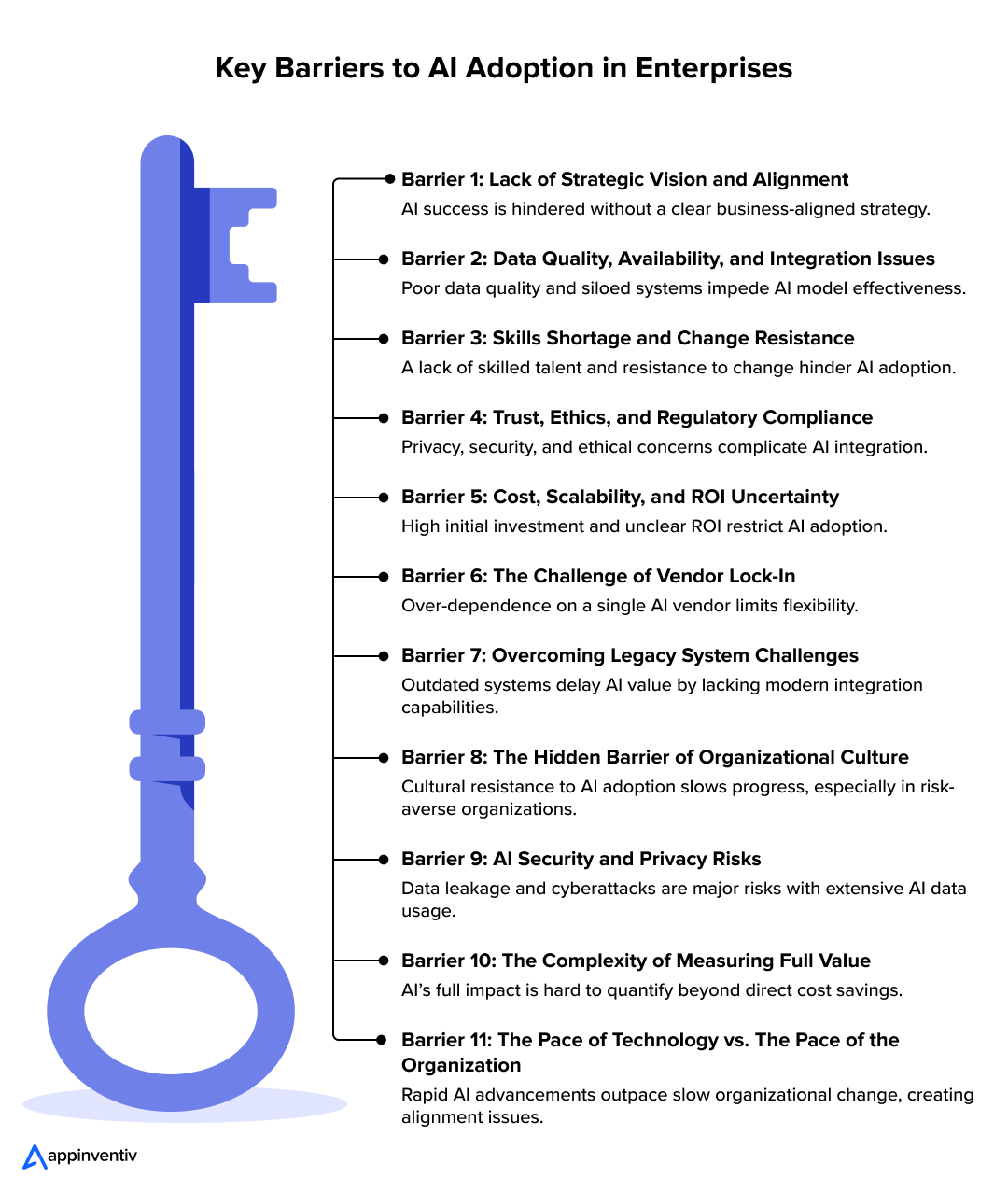
Barrier 1: Lack of Strategic Vision and Alignment
What truly derails AI success? The absence of a business-aligned strategy stands out as the primary obstacle. Enterprises frequently approach AI reactively, treating it like the latest “shiny new thing” instead of integrating it within their broader digital transformation efforts. Such scattered approaches represent the most significant AI implementation challenges facing today’s businesses. Without unified objectives, these initiatives inevitably become isolated and ineffective.
Must Read: Guide To Building an AI Business Strategy for Your Company
Solutions:
- Develop a Business-Aligned AI Strategy: Successful AI integrations require strategy that integrates deeply within organizational business objectives. Rather than asking “What can AI accomplish?” the better question becomes “Which specific business challenges demand solutions, and might AI provide the answer?”
- Involve Cross-Functional Stakeholders: Think of AI as a collaborative endeavor. Assemble leaders spanning operations, marketing, finance, plus legal departments to shape your strategic roadmap.
- Set Measurable Goals and a Phased Roadmap: Establish clear success definitions upfront. Begin with high-impact, quick-win scenarios that generate early momentum and demonstrate concrete value.
Real-World Success: Italgas Group’s strategic AI alignment demonstrates how clear vision drives measurable impact. As Europe’s leading gas distributor, Italgas strategically prioritizes AI initiatives that enable its vision to lead gas distribution and modernize national infrastructure. Their Digital Factory innovation unit executes AI initiatives with close involvement of the executive team. In 2024, eighteen cross-functional teams delivered MVPs in four-month sprints, each sponsored by a C-level executive.
Barrier 2: Data Quality, Availability, and Integration Issues
Any AI system is only as good as the data it’s trained on. For most organizations, data exists in silos across different departments, often in legacy systems that don’t talk to each other. This creates a triple-threat challenge: poor data quality, limited availability, and integration difficulties. This is a primary example of one of the many challenges in AI adoption.
This challenge becomes even more critical for generative AI adoption – these models require massive, high-quality datasets for fine-tuning. Without proper data foundations, AI models deliver generic outputs that fail to address specific business needs, severely limiting their value and representing one of the most significant enterprise AI adoption challenges.”
Solutions:
- Implementing Data Governance and Stewardship: Establish clear protocols for data collection, storage, and usage. Assign dedicated data stewards within each department to ensure accuracy and consistency across all data. The proactive management of data is key to overcoming these challenges of AI adoption in business.
- Investing in Data Integration and Cleansing Tools: Utilize modern data integration platforms, deploy AI in legacy systems, and ETL tools to unify fragmented datasets and automate data cleansing.
- Leveraging Cloud and Modern Infrastructure: Migrate to modern cloud-based data warehouses and data lakes designed to handle massive data volumes required for advanced ML. This is a critical component for addressing AI implementation challenges. Without this, businesses face key AI adoption challenges for enterprises.
While building an AI strategy framework helps identify opportunities, many businesses struggle to execute without expert AI integration consulting to guide deployment, ensure alignment with business goals, and accelerate time-to-value.
Must Read: How Appinventiv Solves AI’s Biggest Development Issues
Real-World Success: Starbucks’ continued investment in data infrastructure pays massive dividends. As of 2024, Starbucks Rewards has nearly 31 million active members, with the company processing over 90 million transactions weekly across 40,000+ stores globally. Their unified data architecture, powered by the Digital Flywheel platform and cloud-based AI engine, analyzes customer preferences, purchase history, weather conditions, and location data in real-time.
This data integration drives their recommendation engine, which accounts for nearly 50% of Starbucks’ revenue – with reward program members generating substantially higher transaction values. The company reported $36.18 billion in revenue for fiscal 2024, demonstrating how proper data infrastructure creates lasting business value and customer loyalty.
Barrier 3: Skills Shortage and Change Resistance
Even with the best technology and clear strategy, AI projects fail without the right people. This creates powerful cultural friction that can derail even well-planned implementations, representing significant AI challenges in organizations. The skills gap and resistance to change remain among the most common obstacles to AI adoption, making investment in your people critical to any successful business transformation.
The fear of being replaced is natural, but this perspective is vital for a successful AI adoption journey.
Solutions:
- Upskilling and Reskilling Programs for Existing Staff: Empower your existing workforce with training programs that teach basic AI literacy and specialized skills for technical teams.
- Leveraging No-Code/Low-Code AI Tools: User-friendly platforms allow business analysts to build and deploy models without deep coding knowledge. This is another area where many businesses face a unique set of AI adoption barriers in enterprises.
- Fostering a Culture of Innovation and Continuous Learning: Encourage AI as an augmentation of human capabilities, celebrating small wins and lessons learned. The proactive management of change is a core part of overcoming AI adoption challenges and solutions. This is a pressing concern for any leader, and one of the key AI challenges for CTOs.
Real-World Success: Unilever’s AI-powered workforce transformation shows measurable results in 2025. Their FLEX Experiences platform, which has trained and reskilled employees with future-fit skills, demonstrates how AI adoption challenges and solutions can be addressed strategically. The company recorded a 41% boost in overall productivity alongside a 20% rise in internal collaboration time. The case concludes by highlighting Unilever’s forward-looking plans to reskill and upskill all employees, preparing them to continue within the company, explore opportunities elsewhere, or adapt to new employment models.
Barrier 4: Trust, Ethics, and Regulatory Compliance
As AI systems integrate into critical business functions, concerns over privacy, data security, and ethics grow. With new regulations like the EU AI Act and India’s DPDPA, regulatory challenges in AI have become more complex than ever. Overcoming these barriers to AI adoption in enterprises requires a proactive approach.
Ethical concerns in AI adoption extend beyond legal obligations to moral responsibilities. Addressing these issues is crucial for mastering AI adoption barriers in enterprises.
Must Read: Dissecting AI’s Fundamental Risks and Their Countermeasures
Solutions:
- Establishing AI Governance Frameworks and Ethical Guidelines: Develop clear principles addressing fairness, accountability, transparency, and data privacy as part of your AI adoption framework.
- Ensuring Regulatory Compliance: Use AI governance platforms to monitor data usage, track model lineage, and maintain audit trails. Managing these AI implementation challenges is vital.
- Building Transparency and Accountability: Implement explainable AI techniques that provide insights into model decision-making processes. This is crucial for navigating complex AI adoption challenges for enterprises.
Real-World Success: DBS Bank’s commitment to responsible AI governance positions it as a leader in ethical AI deployment. As of May 2025, DBS has deployed over 1,500 AI models across 370 use cases following its PURE framework (Purposeful, Unsurprising, Respectful, Explainable) for responsible data use. The bank’s robust governance approach, supported by platforms like ADA (Advancing DBS with AI) and ALAN (AI protocol repository), has reduced time-to-market for AI initiatives from 15 months to under 3 months.
DBS actively collaborates with Singapore’s Monetary Authority and participated in developing the Model AI Governance Framework, becoming one of the first banks to test AI Verify – the world’s first AI Governance Testing Framework. These governance investments delivered SGD $750 million ($585 million) in economic value in 2024, with projections exceeding SGD $1 billion by 2025, demonstrating how ethical AI frameworks drive both trust and measurable business results.
Related Read: How to Reduce Bias in AI Models
Barrier 5: Cost, Scalability, and ROI Uncertainty
Proving AI ROI presents a unique challenge: traditional financial metrics often miss the technology’s strategic value. While executives scrutinize every dollar spent – particularly in large enterprises where budgets face intense oversight – they lack frameworks to quantify improvements in decision speed, market agility, or competitive positioning. This measurement gap, a core challenge in AI adoption for business, causes leadership to underfund initiatives that could transform their operations.
Solutions:
- Starting with High-Impact, Quick-Win Use Cases: Identify problems where AI delivers clear, measurable value quickly; customer service automation, predictive analytics, recommendation engines.
- Adopting a Phased, Iterative Approach: Treat AI as a continuous investment rather than a single, massive budget allocation.
- Measuring and Communicating ROI: Develop multi-dimensional frameworks that track cost savings, revenue growth, customer satisfaction, and time-to-market improvements alongside strategic value metrics. Successfully measuring and communicating these returns across stakeholder groups – from technical teams to the C-suite – is essential for securing ongoing investment and overcoming AI scalability challenges that prevent pilots from reaching production.
Must Read: How to Scale Your AI Project without Overspending
Real-World Success: Unilever’s phased AI investment approach demonstrates measurable ROI across multiple dimensions. The company’s productivity program launched in March 2024 is targeted to deliver €800 million in savings over three years, with in-year savings close to €200 million achieved by the end of 2024. By starting with targeted pilots – such as H2Ok AI-powered cleaning systems in their Poznan factory that reduced cleaning times by 20%, cut utility use by 10%, and saved €100,000 annually – Unilever proved value before scaling.
Across four manufacturing sites, their AI and talent investment approach showed productivity metrics improving 27% between 2020-2024, waste-reduction metrics increasing by 41% on average, and operational health and safety metrics rising by 28%. By measuring ROI across financial, operational, and strategic dimensions, Unilever secured continued investment to scale globally.
Barrier 6: The Challenge of Vendor Lock-In
Vendor dependence creates cascading risks beyond just switching costs. Organizations lose negotiating leverage, face inflated pricing on renewals, and sacrifice architectural flexibility. When a vendor’s technology roadmap diverges from your business needs, you’re forced to choose between costly migration or compromised capabilities. This enterprise AI adoption challenge demands proactive mitigation from day one.
This is a key concern for leaders today and one of the top challenges of AI adoption.
Solutions:
- Prioritize Open Source and Interoperable Platforms: Choose AI solutions built on open standards and frameworks.
- Develop a Hybrid AI Strategy: Combine vendor solutions with strategic in-house expertise to optimize results. This is critical for managing AI implementation challenges.
- Negotiate for Data Portability: Test data portability during pilot phases; if migration requires vendor assistance or proprietary tools, you lack true data independence and should reconsider the partnership.
Real-World Success: BMW Group’s strategic AI approach demonstrates how to maintain vendor flexibility while scaling AI. The automotive leader develops many AI components in-house while complementing them with off-the-shelf solutions—a hybrid strategy that ensures greater flexibility, reduces risks, and avoids early vendor lock-in. This multi-vendor approach is supported by dedicated AI development teams across six global IT hubs spanning the USA, Portugal, Romania, India, China, and South Africa.
BMW’s GenAI self-service platform gives employees access to multiple AI models while maintaining independence from specific language model providers. The strategy delivers measurable results: their AIconic multi-agent system achieved 1,800 active users performing 10,000 searches shortly after launch, significantly increasing employee efficiency without vendor dependency.
Barrier 7: Overcoming Legacy System Challenges
For large organizations, AI adoption is directly tied to outdated technology infrastructure. Legacy systems often lack APIs and processing power for modern AI applications. The challenges in AI adoption and deployment surface when trying to connect new models to old, rigid systems; a multi-year project that delays value and frustrates teams.
Solutions:
- Adopt Middleware and Integration Platforms: Use platforms that bridge legacy systems and new AI tools.
- Prioritize a Phased Cloud Migration: Migrate systems most critical to your AI roadmap first. This is key to managing enterprise AI adoption challenges.
- Look for AI-Ready Platforms: When investing in new software, prioritize platforms designed for AI integration. This forward-thinking approach helps enterprises overcome adoption barriers as technology continues to evolve.
Real-World Success: JPMorgan Chase’s systematic approach in 2024-2025 demonstrates successful legacy integration. Their AI initiatives saved $1.5 billion in fraud prevention and operational efficiencies, with over 200,000 employees now using JPMC’s LLM Suite. Their NeuroShield AI fraud detection system reduced scam-related losses by 40% while processing billions of transactions through legacy-integrated systems, proving that phased modernization can work at scale.
Barrier 8: The Hidden Barrier of Organizational Culture
Beyond technical skills, one of the most common barriers to AI adoption in business is cultural resistance. Organizations with risk-averse cultures struggle to get AI off the ground. This is where leaders earn their stripes by cultivating a mindset that embraces change.
Solutions:
- Lead by Example and Communicate the “Why”: Leaders must champion AI adoption by using tools themselves and communicating a clear vision.
- Create Safe Spaces for Experimentation: Encourage experimentation through hackathons or innovation challenges.
- Redesign Roles, Don’t Replace Them: Clarify AI as a co-pilot designed to automate mundane tasks, freeing employees for higher-value work.
Real-World Success: Walmart’s culture-first AI approach in 2024-2025 demonstrates leadership impact. CEO Doug McMillon’s vision for “every associate to use AI every day” has driven systematic culture change. Their approach on leadership modeling, AI playground for experimentation, and AI-powered benefits help desk cutting query handling time in half, helped deploy AI across operations while maintaining employee engagement. Walmart’s lead times decreased from 24-26 weeks to 6-8 weeks using AI-powered design tools.
Barrier 9: AI Security and Privacy Risks
Agentic AI adoption challenges intensify security concerns significantly. As these autonomous models consume vast amounts of data and interact with multiple systems without human oversight, risks of data leakage and cyberattacks increase exponentially.
Must Read: Agentic AI in Finance
Solutions:
- Implement a Privacy-by-Design Approach: Embed privacy and security into AI development from the beginning. Navigating these regulatory challenges in AI is crucial.
- Conduct Regular Security Audits: Continuously monitor AI systems for vulnerabilities and threats. This is part of ongoing efforts to address AI adoption challenges for enterprises.
- Provide Employee Training: Educate employees about the risks of unsanctioned AI tools and provide secure, approved platforms. This is the first line of defense and a key part of solutions for generative AI adoption challenges.
Real-World Success: Apple’s privacy-by-design approach in 2024-2025 continues setting industry standards. Apple Intelligence uses on-device processing and differential privacy, contributing to a 25% surge in Apple’s stock from April 2024 lows following their WWDC 2024 announcements. Their ~3 billion parameter on-device language model processes AI features locally, with Private Cloud Compute extending device-level security to the cloud, proving security and functionality can coexist profitably.
Barrier 10: The Complexity of Measuring Full Value
AI benefits aren’t always direct cost savings; they can be subtle and difficult to quantify. Organizations focusing too heavily on short-term metrics fail to capture the full picture of enhanced productivity and competitive advantage. One of the use cases of AI for business optimization challenges is convincing leadership of intangible benefits like faster time-to-market.
Solutions:
- Define Success Beyond the Bottom Line: Track metrics like employee satisfaction, customer retention, time-to-market, and innovation velocity.
- Use a Holistic Measurement Framework: Measure AI impact across financial, operational, strategic, and human-centric dimensions.
- Tell a Story with Your Data: Use data to tell compelling stories about business transformation and meaningful impact. This is essential when tackling AI adoption challenges and solutions.
Must Read: Impact of AI on Mobile Economy
Real-World Success: Walmart’s holistic measurement approach in 2024-2025 demonstrates multi-dimensional value tracking beyond simple cost metrics. The retailer used large language models to create or improve over 850 million pieces of product catalog data—work that would have required nearly 100 times the current headcount to complete manually.
Walmart measures AI impact across customer experience, associate productivity, operational improvements, and content generation, with global e-commerce sales growing 22% in Q1 FY2026 partly attributed to AI-enhanced search and personalization. The company evaluates each AI application using proprietary ROI calculations with specific metrics at defined checkpoints, proving that comprehensive measurement frameworks justify continued AI investment across multiple business dimensions.
Barrier 11: The Pace of Technology vs. The Pace of the Organization
The fundamental disconnect between rapid AI innovation and slow organizational pace creates challenges. New breakthroughs happen weekly, making long-term technology bets difficult. For many, the answer lies in adopting a flexible AI adoption framework that allows constant evolution and strategic pivots. This prevents being locked into outdated systems before they go live.
Must Read: AI TRiSM (Managing Risk, Building Trust, and Securing AI Systems)
Solutions:
- Establish a Center of Excellence (CoE): Create dedicated, cross-functional teams responsible for staying current with AI trends and providing organizational guidance and direction.
- Adopt an Agile Mindset: Break initiatives into small, manageable sprints, allowing quick learning and adaptation.
- Partner with External Experts: Access specialized knowledge needed to navigate the rapidly evolving AI landscape.
Real-World Success: Marriott’s agile AI strategy in 2024-2025 demonstrates how to balance innovation with organizational capability. The hospitality leader invested between $1 billion and $1.2 billion in technology in 2024, with its Automated Complimentary Upgrade system rolling out in July 2025 to automate complex room assignments across 1.2 million rooms. Their systematic approach—an AI incubator exploring 200+ use cases, iterative “learn-as-you-go” methodology, and cloud-native architecture supporting 200 million Bonvoy members—helped them stay competitive while managing technological transformation at a sustainable, enterprise-wide pace.
Your AI journey doesn’t end with knowing the barriers; it begins with solving them. Partner with us to scale AI the right way.
Putting It All Together: Your Strategic Framework for AI Success
After navigating through these eleven barriers, you might be wondering where to start. The key is recognizing that these challenges cluster into four distinct categories. By understanding which poses your greatest risk, you can build a robust AI adoption framework that addresses your organization’s specific needs first.
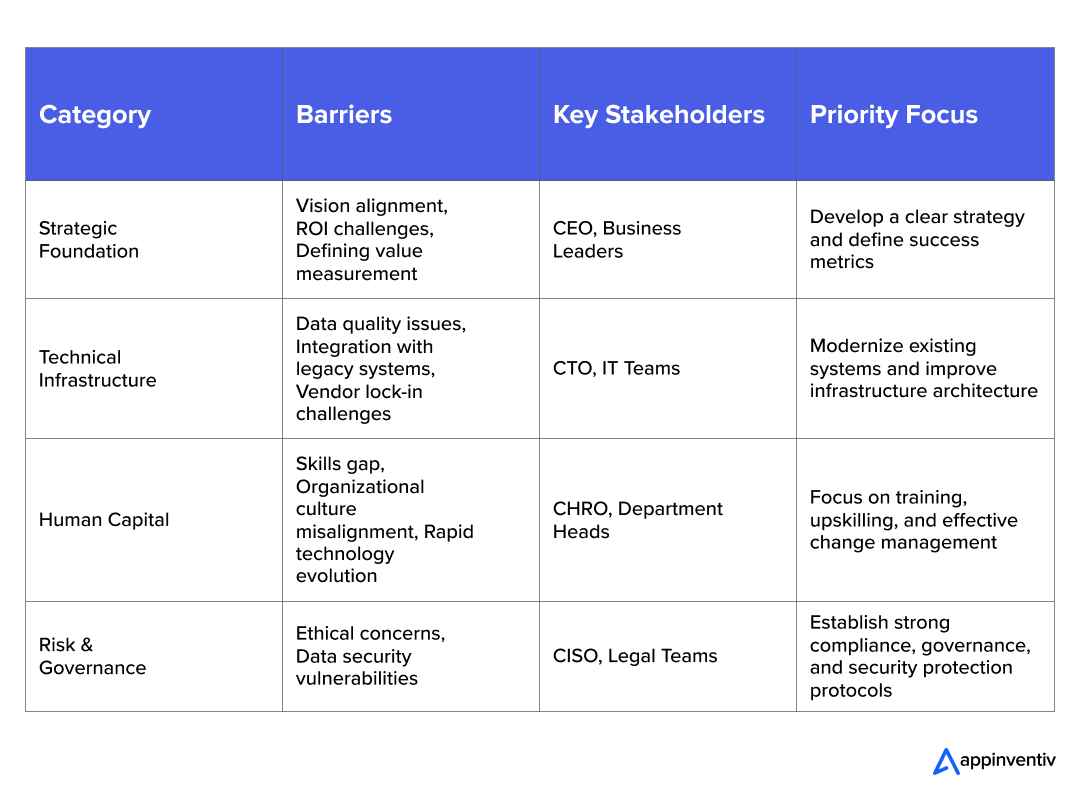
Your Prioritization Roadmap
Start Here: Focus on the Strategic Foundation first because, without a clear vision, technical investments will be wasted. Simultaneously address basic risk and governance to avoid costly mistakes.
Scale Here: Once the strategy is clear, prioritize technical infrastructure to move from pilot to production, while investing heavily in human capital to drive adoption.
Critical Success Questions
Before your next AI initiative, ensure you answer:
- Can you articulate exactly how AI will transform your core business processes?
- Do you have the budget, talent, and executive support to scale beyond pilots?
- Have you established governance protocols to manage AI risks appropriately?
- Can you measure AI’s impact beyond cost savings to include strategic value?
The path from AI aspiration to advantage isn’t about overcoming individual barriers; it’s about building an integrated approach. Organizations that treat these eleven barriers as a strategic checklist, rather than isolated problems, successfully transform from AI experimenters into AI leaders. Your competitors face these same challenges. The difference between success and “pilot purgatory” lies in how systematically you address them.
Your strategic framework is the first step. The next? Scaling with an AI consulting partner trusted by Fortune 500s.
How Appinventiv Helps You Overcome AI Adoption Barriers
Breaking through AI adoption barriers requires more than just technical expertise; it demands a partner who understands your unique challenges and delivers proven solutions. As a leading AI development services provider and Deloitte Technology Fast 50 Award winner for consecutive years (2023 & 2024), we stand as the #1 company in the Digital & Cloud Tech category, making us the ideal partner to accelerate your AI transformation journey.
Why Global Leaders Trust Our AI Excellence:
With over 1,600 tech experts across 35+ industries, we have consistently delivered breakthrough AI solutions for world-renowned brands.
For a leading global banking institution, Appinventiv developed comprehensive AI-powered solutions that transformed customer service operations. This intelligent chatbot system started handling over 50% of customer service requests across mobile, web, and messaging platforms.
Key Results:
- 20% reduction in operational costs through automated query resolution
- 20% improvement in customer retention via 24/7 availability
- Seamless NLP-driven understanding of complex banking queries
- Automated routine tasks: balance inquiries, card activation, bill payments, transaction history
The hybrid AI-human approach ensures immediate assistance for routine transactions while maintaining personalized support for complex decisions, positioning our client as an industry leader in digital banking innovation.
Our certifications include:
- ISO 9001:2008 – Quality Management System certification for consistently delivering services that meet customers’ needs and expectations
- ISO-27001 & CMMI Level 3 – Advanced security and process improvement certifications ensuring enterprise-grade, GDPR-compliant software development
From concept to deployment, we, as a trusted AI consulting company, transform AI adoption challenges into competitive advantages, helping you unlock innovation, enhance efficiency, and scale with confidence in today’s rapidly evolving digital landscape.
Contact us today to break through your AI adoption barriers and unlock transformative growth.
Frequently Asked Questions (FAQs)
Q. What are the common obstacles in enterprise AI adoption?
A. Primary AI adoption challenges for enterprises typically center on data quality, plus integration challenges specifically. Numerous enterprises possess fragmented, disorganized datasets requiring substantial remediation before AI systems function optimally overall. The talent shortage presents additional significant complications – locating qualified professionals who grasp both technological aspects and business requirements proves difficult. Financial limitations create considerable pressure, particularly considering the necessary infrastructure expenditures involved. Furthermore, securing commitment from executives and staff members potentially concerned about employment stability represents a substantial obstacle that impedes successful implementation.
Q. How to overcome data privacy challenges in AI implementation?
A. Begin with comprehensive data governance – identify existing data assets and establish access protocols accordingly. Integrate privacy safeguards directly within AI architectures from project inception, avoiding retrofitted implementations. Methods including data anonymization, cryptographic protection, plus differential privacy techniques, help secure sensitive information while enabling effective machine learning processes. Maintain compliance with regulatory frameworks like GDPR alongside regional privacy legislation.
Systematic security assessments identify vulnerabilities before they escalate into significant incidents. Communicate transparently with customers regarding data utilization practices and provide meaningful control over their personal information. Establishing trust requires considerable time, yet destroying it occurs rapidly.
Q. What are the risks of AI failure in enterprises?
A. AI failures can hit enterprises hard in multiple ways. Financial losses are obvious – wasted investment, operational downtime, and missed opportunities add up fast. Your reputation takes a beating when AI systems make embarrassing mistakes, especially if customers are affected. There’s also the regulatory risk – failed AI projects can trigger compliance issues and legal headaches. Internally, failed implementations kill team morale and make future AI initiatives harder to sell. Security vulnerabilities in AI systems can expose sensitive data. Plus, over-reliance on faulty AI can lead to poor business decisions that have lasting consequences.
Q. How do enterprises address AI scalability challenges?
A. Most organizations approach AI scalability through targeted pilot initiatives, subsequently expanding proven methodologies that demonstrate measurable success. Cloud infrastructure proves crucial – enabling dynamic resource scaling adjustments without requiring massive upfront capital investments. Building modular AI system architectures helps significantly, allowing new capability additions without rebuilding existing systems from scratch.
Data pipelines require sufficient robustness to handle rapidly expanding volumes without experiencing system failures. Many companies increasingly invest in MLOps platforms for automating model deployment and monitoring processes. The key involves planning for growth from the outset while maintaining appropriate technical foundations to support expansion as demand increases.
Q. What are the top barriers to AI deployment in large organizations?
A. Legacy infrastructure frequently presents the most significant challenge—these systems weren’t designed for seamless integration with contemporary AI solutions. Achieving cross-departmental collaboration creates substantial roadblocks, particularly since AI initiatives typically require multidisciplinary team contributions. Executive buy-in becomes complicated when leadership lacks a comprehensive understanding of AI’s transformative potential or realistic implementation timelines. Budget disputes emerge regularly.
This proves especially true when return on investment remains unclear initially. Meanwhile, talent scarcity compounds these difficulties—qualified AI specialists command premium salaries while remaining exceptionally scarce. Regulatory frameworks introduce additional delays, most notably within heavily regulated sectors. Employee cultural resistance toward organizational change completes the primary obstacle landscape confronting today’s enterprises.


- In just 2 mins you will get a response
- Your idea is 100% protected by our Non Disclosure Agreement.

How Much Does It Cost to Build an AI App in Dubai?
Key takeaways: AI app costs in Dubai typically range from AED 80,000 for simple builds to AED 800,000+ for enterprise systems. Dubai is past AI experimentation, and not investing now means catching up later at higher cost. The real budget is driven by data, integrations, architecture, and compliance, not just app features. Hidden costs like…
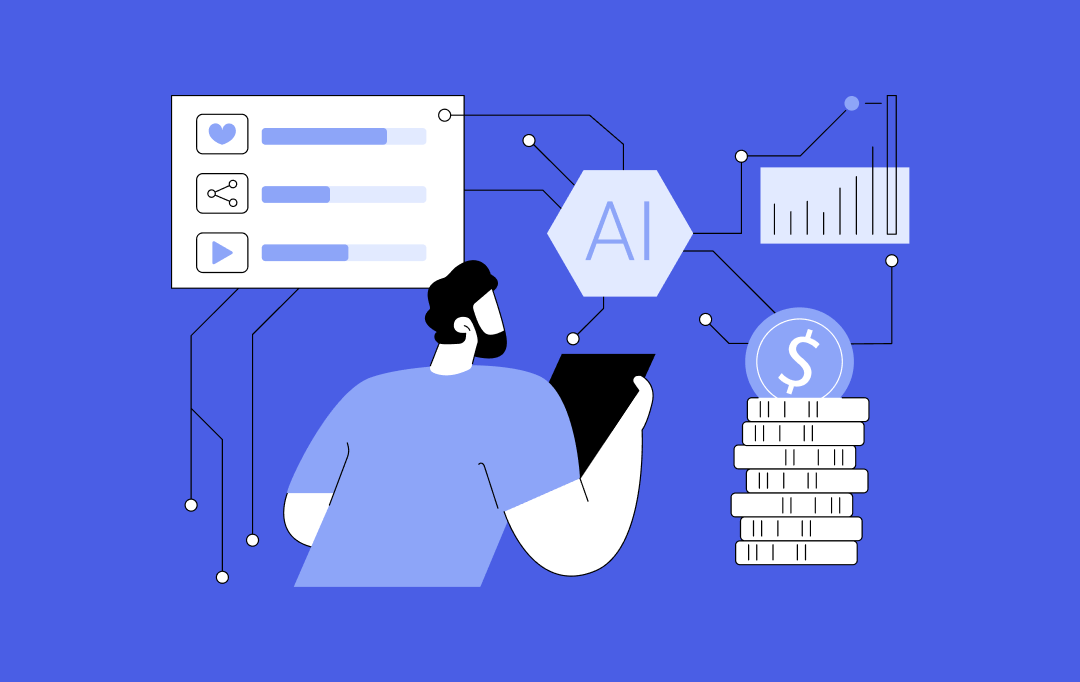
How AI Tokenization is Enabling Secure and Transparent Asset Ownership in 2026
By 2026, AI tokenization has moved beyond early-stage experiments and pilot projects. Tokenizing real-world assets has become a serious commercial strategy for financial institutions, supply chain operators and technology-driven enterprises. A 2025 report by the World Economic Forum in collaboration with Accenture highlights tokenization as a key mechanism for value exchange in modern financial markets.…

13 Ways Generative AI is Transforming the Hospitality Industry
Key takeaways: The most mature applications of Generative AI for hospitality are in guest service, revenue management, marketing, and operations automation. Real value comes from integrating generative AI into hospitality operations and existing PMS, CRS, CRM, and POS systems, rather than using stand-alone tools. Successful programs treat Generative AI in hospitality as a product, incorporating…


























